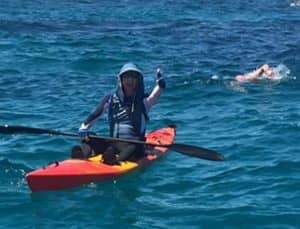March 2017 News from the Clinic
Welcome to the March 2017 Clinic News.
Rotto Swim
It was recently Rottnest Channel Swim time again and whilst the regular team of 4 missed out on an entry this year, Paul with his eldest daughter paddled to Rottnest to support a swimming duo. It was a glorious day, near perfect conditions and the swimmers completed the open water swim in excellent time.

Australian Hand Surgery Society Scientific Meeting
Mr Jarrett spent 4 days last week in Melbourne at the Australian Hand Surgery Society annual scientific meeting. The meeting started with a cadaver workshop on free tissue transfer for microsurgical reconstruction of the proximal scaphoid pole. Following this were three days of talks and discussions where Mr Jarrett chaired one session, presented minimally invasive distal radial fracture fixation to the attendees and tutored at a cadaver workshop on minimally invasive distal radial fixation.
Minimally Invasive Surgery
In recent years, it has been possible to undertake many operations in the hand and upper limb minimally invasively. Arthroscopy has been common for many years and for instance rotator cuff repairs in the Shoulder and TFCC repairs (triangular fibrocartilage complex) in the wrist are now routinely undertaken by Mr Jarrett entirely arthroscopically.
More recently some operations are now possible endoscopically (using a telescope in the soft tissues and not in a joint) and Mr Jarrett’s patients already enjoy the benefits of procedures such as endoscopic distal biceps tendon repair or endoscopic ulnar nerve decompression at the elbow where the tiniest 1-2 cm incisions are used with substantial improvements in recovery time and comfort post-surgery.
Mr Paul Jarrett also undertakes minimally invasive distal radial fracture fixation, a very recent innovation, where the incision is usually only 1.5 cm long and a plate is used with a special aiming jig which Mr Jarrett was the first surgeon in Australia to have access to. Mr Jarrett’s patients who have had the benefit of his innovative expertise seem to recover considerably more quickly with a more cosmetically pleasing incision and we are working to develop these technologies even further to improve our patient outcomes.
